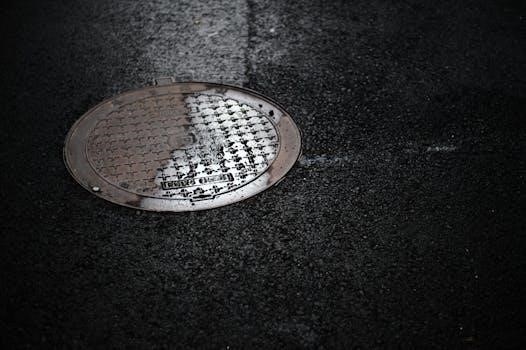The City of Columbus Stormwater Drainage Manual establishes stormwater control requirements for all new development and redevelopment projects. This crucial document outlines standards for managing stormwater quantity and quality within the city.
Overview of the Stormwater Drainage Manual
The Stormwater Drainage Manual serves as a comprehensive guide for managing stormwater runoff in Columbus, Ohio. It provides detailed specifications and standards for designing, constructing, and maintaining stormwater management facilities. The manual addresses both water quality and quantity, aiming to minimize pollution and prevent flooding. It is an essential resource for developers, engineers, and city officials involved in land development projects. The manual also incorporates Ohio EPA regulations and best management practices. Furthermore, the manual helps in complying with NPDES permit requirements. The manual ensures sustainable stormwater management practices across the city. This includes sediment and erosion control standards. Ultimately, the manual promotes responsible development while protecting Columbus’s water resources. The manual is regularly updated to reflect current environmental standards.
Purpose and Scope of the Manual
The primary purpose of the Stormwater Drainage Manual is to establish clear and consistent stormwater control requirements for all development activities within the City of Columbus. It aims to protect the city’s water resources, reduce flood risks, and ensure compliance with environmental regulations. The manual’s scope encompasses all new public and private development and redevelopment projects that impact stormwater runoff. It provides specific guidance on designing and implementing stormwater management practices to minimize pollution and control runoff volume. The manual also addresses various aspects of stormwater management, including water quality treatment, detention, and conveyance. It intends to help achieve Ohios standards. The manual helps in urban stream protection. Furthermore, the manual aims to achieve climate change resiliency. The manual promotes sustainable water resources management throughout Columbus.
Applicability to New Development and Redevelopment
The Stormwater Drainage Manual applies to all new development and redevelopment projects within the City of Columbus. This includes residential, commercial, industrial, and public projects that alter land use and generate stormwater runoff. Any project that increases impervious surfaces or modifies existing drainage patterns falls under the manual’s purview. Redevelopment projects are also subject to the manual’s requirements, particularly those that involve significant site modifications or expansions. The extent of the manual’s applicability depends on the project’s size, location, and potential impact on stormwater runoff. Projects within the Hellbranch Run watershed overlay are subject to additional principles and requirements. These principles implement stormwater best management practices within the development site. Developers and property owners must comply with the manual’s standards to obtain necessary permits and approvals from the city.

Stormwater Control Requirements
The City of Columbus Stormwater Drainage Manual mandates specific stormwater control requirements. These requirements address both water quality and water quantity. Compliance is essential for all new development and redevelopment projects.
Water Quality Control Standards
The City of Columbus Stormwater Drainage Manual sets forth stringent water quality control standards to protect local waterways from pollution associated with stormwater runoff. These standards aim to minimize the discharge of pollutants, including sediment, nutrients, and other contaminants, into rivers and streams. Compliance with these standards is mandatory for all new development and redevelopment projects within the city limits.

Developers are required to implement best management practices (BMPs) to effectively treat stormwater runoff and remove pollutants. These BMPs may include detention basins, constructed wetlands, and other engineered systems designed to improve water quality. The manual provides detailed guidance on the selection, design, and maintenance of appropriate BMPs to meet the specified water quality standards.
Regular monitoring and reporting are also required to ensure the ongoing effectiveness of stormwater treatment measures.
Water Quantity Control Standards
The City of Columbus Stormwater Drainage Manual establishes water quantity control standards to manage stormwater runoff volume and flow rates from development sites. These standards are designed to prevent flooding, erosion, and other negative impacts associated with increased stormwater discharge. Compliance with these standards is essential for all new construction and redevelopment projects in Columbus.
The manual outlines specific requirements for stormwater detention and retention, aiming to mimic pre-development hydrological conditions. Developers must implement measures to control peak flow rates and reduce the overall volume of stormwater leaving their sites. These measures may include detention basins, underground storage systems, and infiltration practices.
The manual provides detailed guidance on calculating design storm events and sizing stormwater management facilities to meet the required control standards. Proper implementation of these standards is crucial for protecting downstream properties and maintaining the integrity of the city’s drainage infrastructure.
Stormwater Management Plan Requirements
The City of Columbus requires a comprehensive Stormwater Management Plan (SWMP) for all new development and redevelopment projects, as detailed in the Stormwater Drainage Manual. This plan outlines how stormwater will be managed on-site to meet the city’s water quality and quantity control standards. The SWMP must be submitted and approved before any construction activities can begin.
The plan must include detailed information about the project site, including existing conditions, proposed development plans, and drainage patterns. It should also describe the specific stormwater management practices (SMPs) that will be implemented to control runoff volume, peak flow rates, and pollutant loads. These SMPs must be designed in accordance with the manual’s technical standards.
The SWMP must also address long-term maintenance and inspection of the stormwater management facilities. This ensures that the facilities continue to function effectively over time, protecting water quality and preventing flooding. The plan must clearly outline the responsibilities of the property owner or operator for maintaining the SMPs.

Compliance and Regulations
Compliance with the City of Columbus Stormwater Drainage Manual is mandated through various regulations. These include Ohio EPA NPDES permit requirements and the City of Columbus Municipal Code Title 13, ensuring adherence to stormwater management standards.
Ohio EPA NPDES Permit Requirements
The City of Columbus operates under the Environmental Protection Agency’s (EPA) National Pollutant Discharge Elimination System (NPDES) permit program. This program, established by the Clean Water Act, addresses pollution sources, including Municipal Separate Storm Sewer Systems (MS4s). Columbus’s MS4 permit necessitates a comprehensive stormwater management program.
As part of NPDES permit compliance, the city must develop and implement a Stormwater Management Program (SWMP). This SWMP outlines strategies for controlling pollutants in stormwater discharges. The Phase II NPDES regulations further regulate Columbus, requiring adherence to specific stormwater management practices.
Various tools and training are available to facilitate compliance with Ohio’s NPDES permit requirements. These resources aid in stormwater practice design, stormwater management plan review, and construction site inspection, ensuring that the city meets its regulatory obligations for water quality protection.
City of Columbus Municipal Code Title 13
City of Columbus Municipal Code Title 13 addresses public services, including stormwater management. It dictates how stormwater shall be discharged, prioritizing storm sewers or open drainage courses over combined sewers when reasonably available. Title 13 provides the legal framework for stormwater regulations within the city.
Director of Public Works administers the Stormwater Rules and Regulations, ensuring compliance with the Municipal Code. The City Manager appoints the Director of Public Works as the authorized enforcement official, granting them the power to enforce stormwater regulations.
Furthermore, the code addresses illicit discharges, prohibiting unapproved substances from entering the stormwater system. Title 13 works in conjunction with other regulations and the Stormwater Drainage Manual to protect water quality and manage stormwater effectively within Columbus.
Stormwater Rates and Service Charges (Chapter 1149)
Chapter 1149 of the Columbus City Codes establishes stormwater rates and service charges. This chapter outlines the financial mechanisms for funding stormwater management activities within the city. Monies collected from these charges are specifically designated for stormwater management purposes, ensuring dedicated funding.
The chapter defines an Equivalent Residential Unit (ERU) which is used to calculate stormwater fees for properties. These fees are intended to address the cost of managing stormwater runoff within the city. Chapter 1149 also addresses the distribution of stormwater system revenues and the utilization of funds.
Properties that reduce stormwater runoff can reduce the city’s costs. By properly managing stormwater, residents and businesses can contribute to sustainable management and help reduce costs for everyone.

Resources and Implementation
Various resources are available to aid compliance with regulations. Training is offered for design, plan review, and inspection. The Stormwater Management Utility provides further resources for effective stormwater management practices in Columbus.
Ohios Rainwater and Land Development Manual
Ohio’s Rainwater and Land Development Manual is a crucial resource, defining the state’s standards for stormwater management practices implemented during land development activities. This manual provides specifications for stormwater management and urban stream protection, ensuring projects meet environmental requirements.
A stormwater pollution prevention plan must address all minimum components of the construction general permit (CGP) and conform to the manual’s specifications. This ensures comprehensive stormwater management during construction. The manual offers guidance on various tools and techniques.
The manual facilitates compliance with Ohio’s NPDES permit requirements and other regulations. It serves as a vital reference for developers, engineers, and regulators involved in land development projects within Ohio and Columbus.
Stormwater Management Utility (SMU) Resources
The Stormwater Management Utility (SMU) provides valuable resources for managing stormwater in Columbus. The SMU offers general rules and regulations pertaining to its operations, ensuring clarity and compliance for all stakeholders. Currently, the SMU is updating its Sediment and Erosion Control Standards.
Consult available resources for the latest information on sediment and erosion control practices. The SMU plays a critical role in stormwater management within the city. It provides guidance on best practices and regulatory requirements to help minimize the impact of stormwater runoff.
The Director of Public Works administers these Stormwater Rules & Regulations. The SMU is committed to promoting responsible stormwater management and protecting the environment. Resources are available to help residents and businesses make a positive impact.
Hellbranch Run Watershed Overlay Principles
Development within the Hellbranch Run watershed overlay is subject to specific principles designed to implement stormwater best management practices. These principles aim to protect the sensitive ecological balance of the watershed. Plans are typically submitted after the preliminary site plan meeting, ensuring early consideration of stormwater management strategies.
The stormwater management facilities and layout requirements must adhere to acceptable project standards. These requirements aim to minimize the impact of development on the watershed’s hydrology. Successfully designing and implementing these facilities is crucial for environmental stewardship.
The principles promote sustainable development practices that prioritize water quality and quantity management. They are intended to guide developers in creating projects that integrate seamlessly with the natural environment. These plans are essential for protecting the Hellbranch Run watershed.

